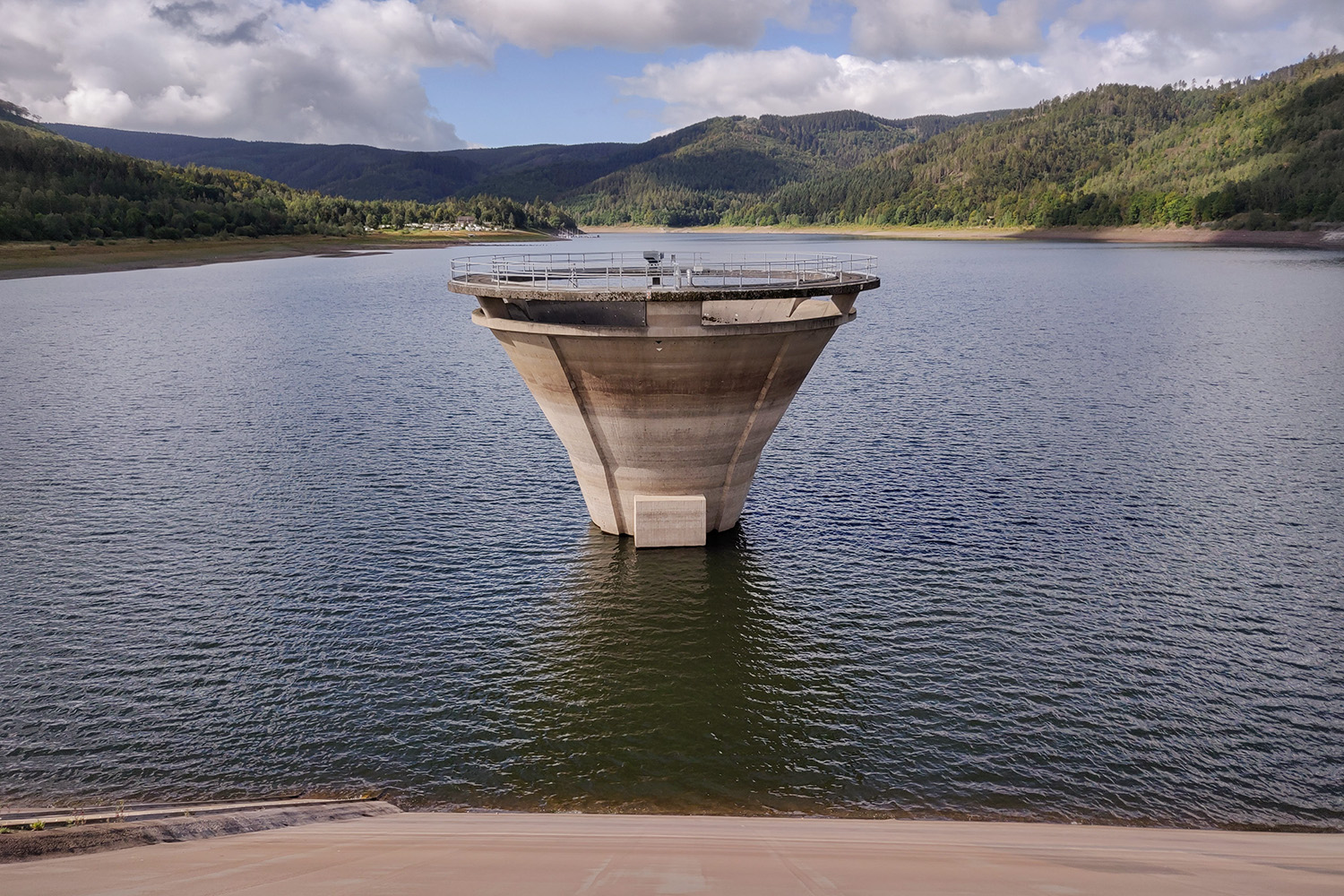The future of the energy and water reservoir in the Harz Mountains Leichtweiß-Institute for Hydraulic Engineering and Water Resources simulates possible variants
First a devastating flood, then years of drought and empty reservoirs: extreme weather conditions have had a major impact on the Harz Mountains and its foothills in recent years. Since 2019, the joint project “Energie- und Wasserspeicher Harz“ (EWAZ) (Energy and Water Storage Harz), funded by the EU and the state of Lower Saxony, has been investigating how the complex system can be further developed for the future in the face of the challenges posed by the effects of climate change. The Department of Hydrology, Water Management and Water Protection (HYWAG) at the Leichtweiß-Institute for Hydraulic Engineering and Water Resources (LWI) at TU Braunschweig is involved in the research, along with TU Clausthal and Ostfalia University of Applied Sciences.
In the summer of 2017, floods inundated the Goslar and Hildesheim regions. In 2018, the whole of Central Europe suffered from extreme heat and drought from spring to late autumn. In 2019 and 2020, northern and eastern Germany also had very little rainfall for many months.
As a result, drinking water reservoirs in the Harz region have emptied to an alarming degree. “To this day, they have not reached the levels that are usual in late spring,” says Professor Günter Meon of the Leichtweiß-Institute for Hydraulic Engineering and Water Resources. Climate change is the cause of these extreme weather anomalies, which climate researchers predict will become more frequent in the future.
A task of the century lies ahead
Harzwasserwerke GmbH operates the reservoirs in the western Harz region. “It is feared that in the medium to long term there will be a shortage of water in the region between the Harz Mountains and the Heath down to the coast as a result of climate change,” says Professor Meon. A secure strategy for the sustainable management of the Harz water reservoir, as demanded by politicians and society up to the year 2100, is a task for the century.
Together with his research assistants Patrick Nistahl and Tim Müller, Professor Günter Meon is part of the joint research project “Energy and Water Storage Harz” (EWAZ). It is funded by the European Union and the Lower Saxony Ministry of Science and Environment with a total of 1.6 million euros.
Thinking the unthinkable
According to Professor Günter Meon, the aim of EWAZ is to develop water management and energy technology measures in the western Harz Mountains to mitigate the effects of climate change on the water supply from the Harz Mountains, the risk of flooding and the low water situation in the region’s water bodies. In addition, energy production with the dammed water will be considered.
The scientists are allowed to think the unthinkable, Meon points out: “We have not imposed a ban on thinking and are allowing all possible system extensions, such as new dams, transfers and pumped storage plants, as project variants.” In addition to the existing system, six other sites are being studied to help the Harz region’s water industry adapt to climate change.
The focus here is on variants that fulfil all the functions of the dams. For example, a large quarry could be used as a second reservoir for the Oker dam, thus not only supporting the drinking water supply, flood protection and low water levels, but also making the Oker dam usable as a pumped storage plant. At other locations in the western Harz region, the experts in the joint project are investigating additional surface and underground reservoirs, as well as additional transfers between existing structures. This type of networked operation is intended to ensure intelligent management of water resources to better respond to changes in climate, water and energy demand.

Professor Günter Meon with his research assistants Patrick Nistahl (left) and Tim Müller (right) in front of the LWI. Photo credit: Markus Hörster/TU Braunschweig
Simulation in the mathematical model
To this end, LWI’s Department of Hydrology, Water Management and Water Protection has developed a mathematical model of the water balance and water infrastructure of the western Harz region. “It is based on meteorological time series that are processed as spatial data fields from the past and for the future,” explains Professor Meon. To do this, the scientists use data from the water management authorities, the Harz waterworks and research results from the research project “Global Climate Change – Water Management Impact Assessment for the Inland” (KliBiW), in which the LWI is also involved. As part of KliBiW, Professor Meon’s department has been quantifying climate change and its effects on floods and low water levels for 13 years in cooperation with the Leibniz University Hannover and the Lower Saxon State Department for Waterway, Coastal and Nature Conservation (NLWKN) on behalf of the Lower Saxony Ministry of the Environment.
“For the period 1881 to 2019, for example, the trend analysis of measured temperatures in Lower Saxony shows an increase of 1.6 degrees Celsius,” says Meon. At the end of the 1980s, there was a sharp rise of around one degree Celsius. In particular, annual maximum temperatures and their duration in the form of heat waves have increased significantly. Annual precipitation has also increased by about 13 per cent on average.
The projections up to the year 2100 are based on the unfavourable but realistic climate scenario “RCP8.5”. In concrete terms, this means that Lower Saxony can expect a further rise in average temperatures of around 3.0 to 3.8 degrees Celsius by 2100 and a significant increase in heat waves. The amount of precipitation in the winter half-year will increase, while the development of the average precipitation in the summer half-year will vary regionally. Extreme precipitation will increase and fall in shorter periods, causing severe weather. In the distant future (2071-2100), floods will become much more severe and droughts much more frequent.

“Our mathematical model for the water balance and water infrastructure of the western Harz Mountains is based on meteorological time series, which are processed as spatial data fields from the past and for the future,” says Professor Meon. Photo credit: Markus Hörster/TU Braunschweig
Consolidation of data in EWAZ
In the EWAZ project model, the data from all the sub-projects are combined in variants. “The model has a high spatial resolution and allows a simulation of the hydrology and the water and energy system on an hourly and daily basis,” explains Professor Günter Meon from the Leichtweiß Institute of Hydraulic Engineering. “With the model, which is fed with time series from KliBiW, we can quantify and optimise the interactions between the four system services of flood protection, drinking water supply, low water replenishment and energy production in particular.”
Effectiveness parameters can be derived for each project variant. One example is the reliability of drinking water supply in the period 2041 to 2070 in competition with low water and flood protection. The researchers in the EWAZ collaborative project, which will run until summer 2022, are carrying out a socio-economic and regional economic assessment. The results of the simulations should lead to recommendations for planning and operation. The aim is to clarify which measures have the greatest economic benefit.
Based on this, environmental studies and technical specifications for certain prioritised options will be developed in follow-up projects. If the measures are implemented, the western Harz region will need an operational water management control system that can be operated with real-time forecasts of inflows. However, according to Professor Günter Meon, this is the subject of another chapter of research.

